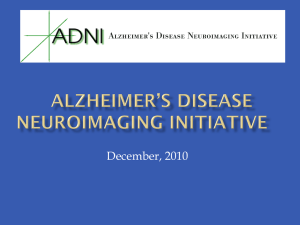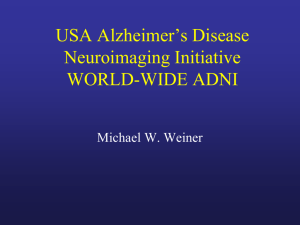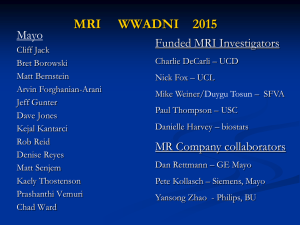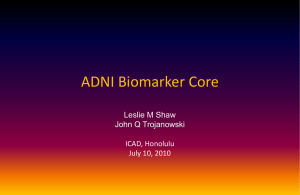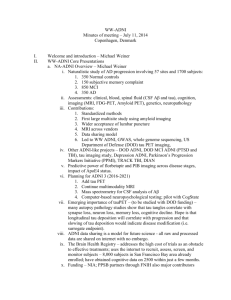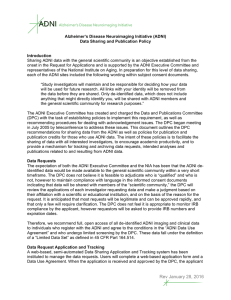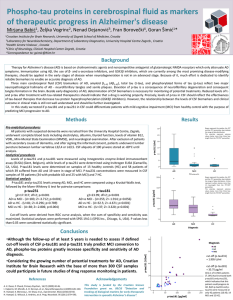GO/ADNI 2 MRI protocol
advertisement
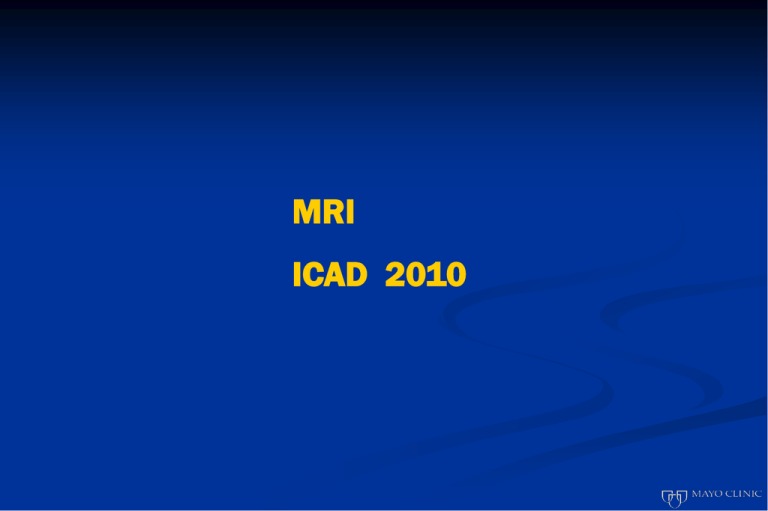
MRI ICAD 2010 Outline ADNI 1 - Summarize most important results – internal and external ADNI investigators From ISAB summary of reasoning and pilot work behind final GO/ADNI 2 protocol Summarize QC procedures for new sequences Summarize parameters of sequences Previous ADNI session Dx, prediction, rates of change, sample size Brewer/Dale – Freesurfer Barnes/Fox Schuff – all the above also APOE and CSF effects ADNI 1 image analysis results MRI has better longitudinal power to detect change than clinical instruments, resulting in smaller sample sizes for clinical trials in both MCI and AD patients Provided sample size estimates for powering clinical trials for MCI and AD, comparing various methods Measurement method matters: some MRI analysis methods had greater longitudinal power than others best performing MRI measures overall TBM, BSI, Freesurfer greater white matter hyperintensity load in AD than control and in MCI than control subjects who would be typically enrolled in therapeutic trials [Carmichael] use as co variate in clinical trials Hua et al Sample Sizes per Arm Needed to Power Treatment Study in AD/MCI Citation Subjects Source of subjects Measurement Method Sample size required to detect treatment effects Holland et al 2009 (51) 129 AD 299 MCI Referral sample ADNI Ctx thickness ERC ROI Assuming 24 month trial, 25% effect size, 80% power, scans every 6 mo; 45 AD per arm; 135 MCI per arm Hua et al 2010 (52) 50 AD 122 MCI Referral sample ADNI TBM temporal lobe Assuming 12 month trial, 25% effect size, 80% power; 43 AD per arm; 82 MCI per arm Leung et al 2010 (53) 81 AD Referral sample ADNI KN-BSI Assuming 12 month trial, 25% effect size, 80% power; 81 AD per arm Schuff et al 2009 (54) 96 AD 226 MCI Referral sample ADNI Hippocampal volume (SNT), model includes 3 scans, Markov chain, APOE Assuming 12 month trial, 25% effect size, 90% power; 186 AD per arm; 341 MCI per arm Vemuri et al 2010 (50) 71 AD 149 MCI Referral sample ADNI Ventricular –BSI Assuming 12 month trial, 25% effect size, 80% power, 2-sided 2 sample t-test at 0.05; 100 AD per arm; 186 MCI per arm Wolz et al 2010 (55) 126 AD 279 MCI Referral sample ADNI Simultaneous 4D graph Segmentation Assuming 12 month trial, 25% effect size, 80% power, 2-sided 2 sample t-test at 0.05; 67 AD per arm; 206 MCI per arm Cross Sectional Separation of Clinically Diagnosed AD vs. Controls Citation Subjects Source of subjects Measurement Method Results Gerardin et al 2009 (27) Neuroimage CN 25 AD 23 Referral sample ADNI Hippocampal shape metric Sens 96%, spec 92% Hinrichs et al 2009 (28) CN 94 AD 89 Referral sample ADNI Multi voxel classifier AUROC 0.88 Kohannim et al 2010 (30) CN 213 AD 158 Referral sample ADNI Multi voxel classifier AUROC 0.89 McEvoy et al 2009 (31) CN 139 AD 84 Referral sample ADNI Ct thickness; med and lat temporal, isthmus cingulated orbito frontal Sens 83%, spec 93% Walhovd et al. 2010 (32) 42 CN, 38 AD Referral sample ADNI Ct thickness 85% ADNI 1 image analysis results MRI rates of change in cognitively normal subjects are greater in APOE e4 carriers than non-carriers [Schuff, 2009; Morra, 2009; Fjell, 2010] lower CSF A42 was associated with a thinner cortex in cognitive healthy controls [Tosun, 2010] No difference between 1.5T and 3T in group-wise discrimination or sample sizes needed to power trials [Ho, 2009] Association between low baseline CSF A1-42 concentrations and cortical thickness in cognitive normal elderly - Tosun, 2010 CSF AB and decreased brain volume in cognitively normal elderly (CDR 0) Fagan et al Annals 2009 Dynamic Biomarkers of the Alzheimer’s Pathological Cascade Jack et al, Lancet Neurol 2010; 9: 119-28 Ab Amyloid = CSF Ab42 or amyloid PET imaging; Tau Mediated Neuron Injury and Dysfunction = CSF tau or FDG PET; Brain Structure = structural MRI Annual change in global PIB ratio and ventricular volume by clinical diagnosis PIB positive subjects (baseline global cortical PIB ≥ 1.5) are represented with triangles and PIB negative subjects (baseline global cortical PIB < 1.5) are represented with circles. Jack et al, Brain 2009 132 (Pt 5):1355-65 ADNI: Predicting time to conversion from MCI to AD from baseline biomarkers – univariately Vemuri et al Neurology 2009 Model summaries from age-adjusted Cox proportional hazards models of time from aMCI to AD. The biomarker enters the model as restricted cubic spline with three knots. Biomarker Model χ2 (P)* Nonlinearity χ2 (P)† Q3 vs. Q1 HR (95% CI) ‡ C-index§ STAND-score 19.0 (<0.001) 1.5 (0.22) 2.6 (1.7, 4.2) 0.69 Aβ1-42 8.2 (0.02) 5.4 (0.02) 0.8 (0.5, 1.3) 0.62 log(t-tau) 6.8 (0.03) 5.0 (0.03) 1.7 (1.1, 2.6) 0.60 log(p-tau181P) 6.6 (0.04) 1.5 (0.22) 1.8 (1.1, 2.9) 0.61 11.0 (0.004) 8.5 (0.004) 2.0 (1.1, 3.4) 0.62 log(t-tau/Aβ1-42) * 3 degree of freedom likelihood ratio test of biomarker significance given that age is in the model † 1 degree of freedom likelihood ratio test of nonlinearity of biomarker effect given that age is in the model ‡ Hazard ratio (95% CI) comparing the third quartile (75th percentile) to the first quartile (25th percentile) of the biomarker. §The concordance index (C-index) in a survival model is analogous to the AUROC in a logistic model and represents the estimated probability the model will correctly predict which of two patients has the longer time until conversion from aMCI to dementia. Effect of APOE on biomarkers •AB chaperone •Hypothesis is e4 would selectively affect amyloid biomarker Vemuri et al, ePub Annals of Neurology, 2010 Conclusions concerning image corrections Metric is sample size per arm to detect a 25% rate reduction in AD – question is, do image corrections reduce technical variance in a meaningful way? 3D Grad warp ~ 10% SS reduction (Gunter, Med Phys, 2009) Scaling correction ~ 12% SS reduction (Clarkson, NI, 2009), image registration (vs phantom) is preferred method Intensity correction improves longitudinal precision – esp multi array coils and 3T (Leow NI 2006; Boyes, NI 2008) Conclusions ADNI phantom value of scanner monitoring - 20% of all ADNI-1 scans would have been affected by errors of various types had each scanner not been monitored [Gunter, 2009] Designed ADNI phantom. Has been adopted as the starting point for quantitative MRI phantom by ISMRM and NIST Outline ADNI 1 - Summarize most important results – internal and external ADNI investigators From ISAB summary of reasoning and pilot work behind final GO/ADNI 2 protocol Summarize QC procedures for new sequences Summarize parameters of sequences GO/ADNI 2 MRI protocol - rational ADNI 1 carry forward subjects: maintain MRI methodological consistency same 1.5T scanner, using ADNI 1 1.5T protocol Discontinue dual 3T/1.5T scans for those in “3T arm” new GO/ADNI 2 enrollees: modernize and expand MRI protocol 3T limit ~ 30-40 minutes (limits # possible sequences in protocol) only product sequences – ie no WIPs Core protocol on all scanners, and vendor specific “experimental” sub studies GO/ADNI 2 MRI 3T Protocol 1. 2. 3. 4. 5. 6. 3D T1 volume unaccelerated (MPRAGE Siemens and Phillips, IR SPGR GE) 3D T1 volume 2X accelerated FLAIR long TE 2D gradient echo Experimental: Siemens (ASL), GE (DTI), Phillips (resting state EPI-BOLD) Phantom (once per day if > 1 ADNI patient) GO/ADNI 2 MRI Core Protocol 1. 1. 2. All newly enrolled GO (and ADNI 2) subjects All vendor systems 3D T1 volume (MPRAGE Siemens and Phillips, IR SPGR GE) Each MRI exam will contain both an accelerated and a nonaccelerated 3D T1 acquisition – * not back-to-back, (3.6%) exam “salvage rate” FLAIR (instead of PD/T2) – better measures of WMH long TE 2D gradient echo (e.g., TE = 20 ms) acquisition for micro hemorrhage detection what is natural history (prevalence and incidence) if MCH and superficial siderosis in a clinical trials population? Phillips MPRAGE unaccel 9:06 Comparison 3T Phillips MPRAGE accel 5:35 3D T1 35 yo GE MPRAGE (ADNI-1) 9:17 volunteer GE IR-FSPGR (ADNI-GO) 9:41 GE IR-FSPGR (ADNI-GO) 5:34 Long TE gradient echo scan Micro Hemorrhages Superficial Hemosiderosis GO/ADNI 2 experimental sub-studies – every subject gets one type *vendor specific – each not done in every subject Why? (1) impossible to standardize without WIPs, (2) no product available, (3) limit 30 - 40 min arterial spin labeling (ASL) perfusion - Siemens diffusion tensor imaging (DTI) – GE resting state functional connectivity – Phillips purpose - to evaluate the feasibility of acquiring useful data in a multi-center (but single vendor) setting - are these techniques useful for clinical trials? Mission of ADNI. QC of experimental sequences Will only repeat exam for quality failure of un accelerated 3D T1 more scans with quality problems in GO/ADNI 2 than ADNI 1 QC information will be more important Raw images vs maps Raw images – QCed at Mayo for protocol compliance, completeness, head coverage, bulk motion, susceptibility artifacts Maps QCed by individual labs (Thompson, DeCarli, Jack, Schuff) that upload numeric data DTI - Color Coded FA Maps From Kantarci et al, in press Neurology Page 1 of 10 GO/ADNI 2 protoocls http://www.loni.ucla.edu/ADNI/Research/Cores/inde x.shtml
